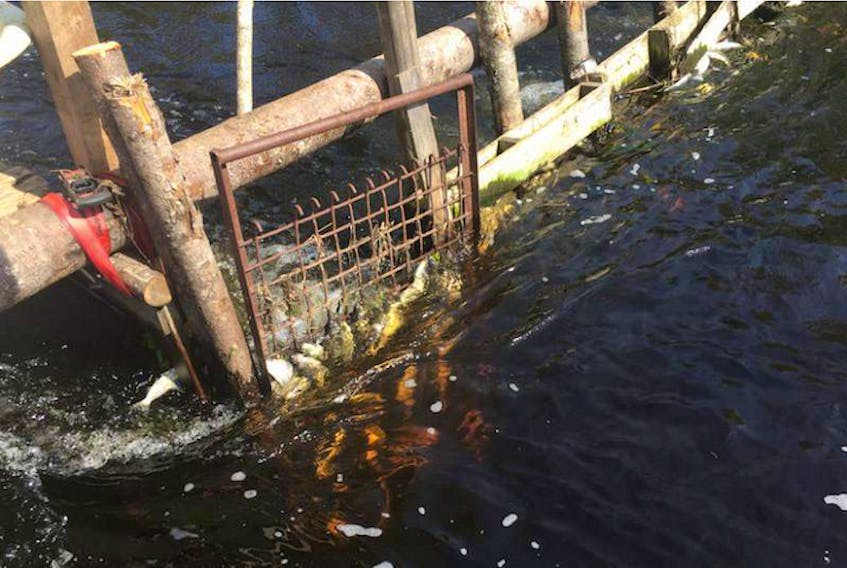WHITE ROCK - Nova Scotia Power has agreed to pay $50,000 to a federal environmental fund for a fish kill involving its White Rock generating station in Kings County last year.
A release from the Department of Fisheries and Oceans Wednesday afternoon said the power corporation has voluntarily agreed to pay the money to the Federal Environmental Damages Fund by March 31.
The agreement was made a few weeks ago, following an investigation by DFO into a violation under the Fisheries Act.
The section in question covers carrying out work or activity that causes harm to fish that are part of a fishery.
Last May 28, a gate at the generating station was opened to create a faster flow of water along a canal for an annual fundraising event that saw numbered rubber ducks placed in the Gaspereau Canal to “race” down the canal.
The increased water flow led to the death of adult gaspereau, the DFO release said. The fish were unable to fight against the increased flow and were drawn into the turbines.
Beside the payment, NSPI has agreed to make repairs to the louvres and bubble curtain meant to direct fish away from the turbines and toward the fish ladder, to hire a third-party consultant to investigate alternative technologies that would exclude fish from the canal during migration, and to find ways to provide support to DFO for real-time fish counts at the White Rock generating plant during the 2018 fishing season.
The power corporation will also no longer “participate in non-operational events which would require the facility to adjust the unit gate to increase water flow downstream.” That means the duck race won’t happen again.
No one from DFO was available to comment Tuesday afternoon.
Nova Scotia Power spokeswoman Tiffany Chase said the payment was part of an agreement with DFO, but the company was not charged under the Fisheries Act after the investigation.
“It was part of our joint discussion when we were coming to the agreement,” she said.
She said the corporation will also incur costs for the other parts of its agreement.
She said the louver and bubble curtain — located in the intake canal about 1.5 kilometres upstream from the generating plant — was repaired last year.
“We fully co-operated in (DFO’s) investigation throughout, and provided information as part of the investigation, and at the conclusion of the investigation we came to the agreement,” she said.
The Fisheries Act sets fines for a first offence under summary proceedings in court at $5,000 to $300,000 for an individual, $100,000 to $4 million for “a person, other than an individual or a corporation referred to in subparagraph (iii).”
That subparagraph refers to “a corporation that the court has determined to be a small revenue corporation,” and set a fine of $25,000 to $2 million.
It’s not clear what category NSP would fall under.
There was no estimate of the number of fish killed.
But Darren Porter, with the Fundy United Federation of Fishermen, alleged hundreds of thousands of fish died that week. He said fishermen on the river reported dead fish on four different days before the duck race.
“The rubber duck race was not an isolated incident,” he said. “There was ongoing and chronic mortality. . . . The river was full (of dead fish).”
He said the $50,000 payment wasn’t sufficient, and wasn’t a penalty.
Asked if he thought NSPI should have been charged, he said, “I’ll put it this way. If they charge any civilians in the province this year, (with Fisheries Act offences), they should chuck it out of court.”
He said the $50,000 wouldn’t even cover what the dead fish would have been worth if it was sold for bait in lobster traps.
“It’s a slap in the face,” he said.
DFO said organizations that focus on the restoration or enhancement of fish habitat on the Gaspereau River, or nearby water systems, will be given priority when applying to the Environmental Damages Fund for any of the $50,000 being contributed by NSPI.
It said the gaspereau stock in the Gaspereau River has been increasing over the past two decades, and more than 1.1 million fish ascended the fish ladder at the generating station last year, up from 400,000 each of the previous two years.
Porter said some of the fish that were killed last year hadn’t spawned.
“We cut them open and they weren’t even spawned . . . they never made it to fill their life cycle.”









